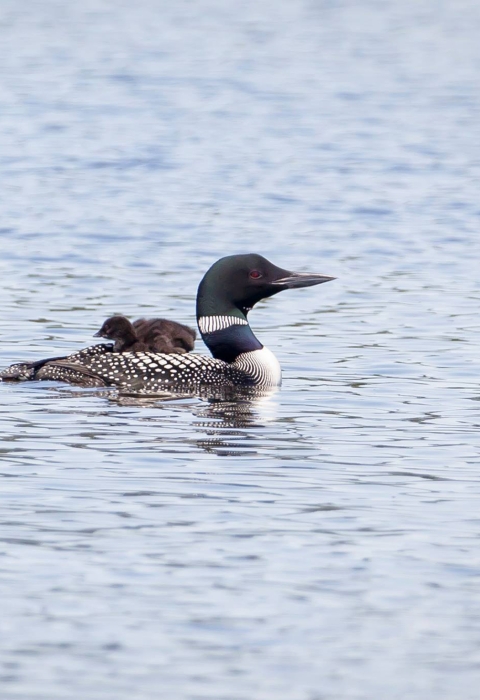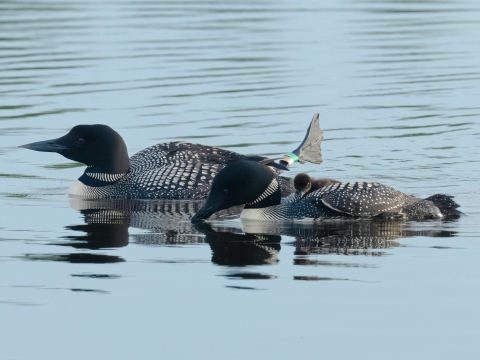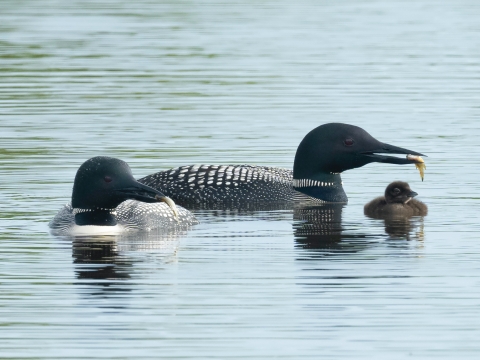A common loon’s iconic wail provides the summer soundtrack to northern waters. Their striking black and white breeding plumage and impressive ability to dive for fish captivate all who are lucky enough to spot them. We at the U.S. Fish and Wildlife Service want to tell you about two particularly impressive common loons - a pair made up of both of the oldest known common loons in the world.
For 25 years, a breeding pair of common loons met up and raised young at Seney National Wildlife Refuge in Michigan’s Upper Peninsula, roughly halfway between Lake Superior and Lake Michigan. As it turns out, this pair is made up not only of the oldest documented common loons in the world, but they are also noted as one of the most productive pairs. What makes this situation even more impressive is that common loons do not typically mate for life.
Identifying birds and observing behavior
Leg bands help identify individual birds so researchers can track their age and movements while observing their behavior without disruption. Refuge biologists banded the male known as ‘ABJ’ in 1987 when he was a young chick, which makes him the oldest common loon of an exact known age. In 1990, on the same waters, researchers banded a female known as ‘Fe’ when she was already a successful mother, making her at least 4 years old. ‘Fe’ has lived on to become the oldest known common loon overall.
Thriving in ideal habitat
What’s the secret to long life and a successful family? Is it good genetics? Good food? A big part of this pair’s success is likely related to where they've chosen to live. Their summer home in the quiet waters among the pines and northern hardwood forests of the Upper Peninsula provides the right combination of food, water and shelter. Seney National Wildlife Refuge is a remote refuge of more than 95,000 acres where more than a dozen common loon pairs breed and raise their young in the summer months. Because these refuge waters are closed to boating, the loons benefit from added security.
Common loons are well adapted to life in the water but are clumsy on land. They choose nesting sites that are close to the water’s edge, but away from mainland predators, allowing them to quickly escape into the water if they feel threatened. Chicks can swim and dive shortly after hatching but are so buoyant they can't get very far under water. It takes a few weeks for young to improve their diving skills. During the first couple of weeks after hatching, chicks commonly hitch a ride on their parents’ backs where they can rest, keep warm and stay safe from predators. Diligent loon parents spend a lot of time protecting their chicks while also catching fish and invertebrates for them to eat, even late into the season - long after the young are capable of catching their own prey.
2022 shake up
’Fe’ and ‘ABJ’ returned to their territory on the refuge in spring of 2022 and were expected to kick off their record 26th consecutive year as a breeding pair. This would have added to their lifetime productivity of 32 hatched offspring and set another record for the species. However, things didn’t go as expected.
Like many bird species, pairs are more likely to break up after an unsuccessful nesting season. In the two-decade span from 1998 to 2017, they failed to produce young only twice. This was a big change for the pair that averaged more than double the rate of the broader breeding population on the refuge. While the pair had an amazing run, recent breeding seasons hadn’t gone as smoothly. Over the past four years, they hatched and fledged only one chick and there were suggestions of a weakening bond. While the pair had been spotted in their typical nesting territory this spring, it was discovered that a different pair was nesting here instead. Researchers did not observe the behavior that led to the split, but it is believed that their failed nesting attempts, including in 2021, drove them to shake things up.
The 2022 season ended with ‘Fe’ pairing with a unbanded male and successfully raised her 40th chick. ‘ABJ’ spent the season alone.
A brief reunion in 2023
In 2023, ‘Fe’ and ‘ABJ’ briefly reunited and were exhibiting normal pair behavior, but by the next afternoon ‘ABJ’ was no longer on the pool and ‘Fe’ was spotted with an unbanded male, likely her mate from 2022. ‘Fe’ and her unbanded mate attempted to breed again but were unsuccessful. ‘ABJ’ paired with a younger female, but their nesting attempt also failed.
‘ABJ’ suffered a broken upper mandible, likely from a territorial fight. After this injury, he disappeared from the refuge, most likely relocating to a much larger body of water with more abundant and easier feeding opportunities. His broken mandible likely made it impossible to remove barbels from brown bullheads, which dominate the waters on the refuge.
Brown bullheads have pronounced barbels around the mouth – essentially long, thick whiskers. Loons on the refuge do not like these nuisance barbels and will remove them through a series of stabbing and pulling actions with their bill before swallowing whole. This is a specialized skill that loons at the refuge acquire over time.
‘ABJ’ was fond of catching a bullhead and compelling his ravenous young to watch as he methodically detached both barbels before serving up the fish. After multiple rounds of this silent instruction, he would then switch to severing only one barbel before offering the fish, compelling his chick to tackle the other unsavory whisker.
Mixed results in 2024
‘ABJ’ returned to the refuge with his bill fully regrown. He had a repeat nest attempt failure with the same female from the year prior. ‘Fe’ hatched two chicks with her unbanded mate, bringing her total known offspring to 42. One chick died shortly after hatching, but the other survived, marking another successful breeding season.
What will unfold in 2025?
As of spring 2025, both ‘ABJ’ and ‘Fe’ have returned to refuge on separate territories. Observers are keen to see whether they will reunite or continue with separate partners this breeding season.
An uncertain future
While the breakup of this power couple may have been devastating for fans, it doesn't necessarily mean the pair has called it quits for good. There have been multiple instances of pairs on the refuge reuniting several years after a split. More to come as their stories continue to unfold.







